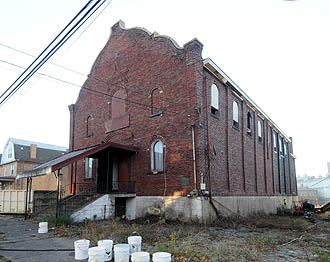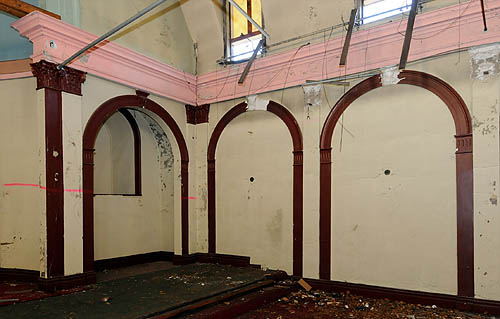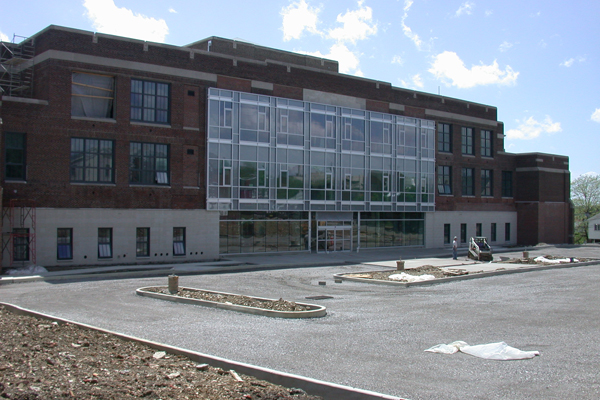
Category Archive: Easements
-
Church Will Be Turned into Condos
Saturday, November 06, 2010By Marylynne Pitz, Pittsburgh Post-GazetteBy next summer, Madonna del Castello Church in Swissvale will be transformed into four condominiums.
Located at 7416 Duquesne Ave., the former Roman Catholic church has been empty for the last five years, said Patrick Shattuck, senior real estate developer for the Mon Valley Initiative.
Mt. Zion Fire Baptized Holiness Church of God of America purchased the church from the Diocese of Pittsburgh in 1987 for $55,000. About five years ago, the congregation moved out, Mr. Shattuck said. In September, Mon Valley Initiative purchased the property for $10,000.
The church has a front Flemish-style gable, a barrel-vaulted ceiling and a large dome over the altar; all of these elements will be incorporated into the redesign.
“The space will certainly be dramatic with the high, barrel-vaulted ceilings. The altar will become a dining room with the dome over it,” Mr. Shattuck said.
The building has been reconfigured by Lami Grubb Architects; renovations will be done by Mistick Construction. The building has stood empty and open to the elements, sustaining major water damage.
“The congregation that took it over actually put a dropped ceiling in. They were unaware that the water damage was substantial. So, they repaired the roof but a good portion of the plaster ceiling fell onto the dropped ceiling. That was when they were forced to move out,” Mr. Shattuck said.
The plaster was actually helping to hold the building together, he said. When structural engineers examined the building, they found gaps between the walls.
“You can see daylight between the front wall and the side walls,” Mr. Shattuck said.
Three of the new units will have 1,600 square feet, two bedrooms and 1 1/2 baths and be priced at $85,000. The fourth unit, which incorporates the dome over the altar, will have three bedrooms, 2 1/2 baths, a study and 2,400 square feet of space. It will cost $105,000.
Asbestos has been removed and the red brick exterior is being cleaned. Cast plaster moldings, six Corinthian capitals and arches in the church will be recast and incorporated into the design. The church sits on a quarter of an acre and there will be off-street parking for residents.
“We own a double adjacent lot next to it. There were two buildings that we had to demolish. It may be that we develop a single new house on the site or it may be that it becomes a community garden space,” Mr. Shattuck said.
-
Setback Won’t Deter Move of Historic House
Friday, November 05, 2010By Len Barcousky, Pittsburgh Post-GazettePaul Orange hasn’t given up hope that he will be able to buy and relocate the historic William Smith House in Mercersburg, despite a setback Thursday.
The house is on land owned by the MMP&W Volunteer Fire Co., which acquired the property in 2009 with plans to expand its aging facilities.
The board that oversees the regional fire company opened bids on Thursday for demolishing the 260-year-old structure but did not consider a proposal from Dr. Orange to move it.
Contacted after the meeting, Dr. Orange said he was advised that his offer to pay the fire company $100 for the building, rather than charge for tearing it down, had not been submitted in the right form.
The fire board, however, took no action on the demolition bids it received during its 15-minute meeting. That decision gives him hope that he still can reach an agreement to preserve the house, he said.
Joel Bradnick, a spokesman for the fire board, said the five bids would be forwarded to the fire company’s engineer for evaluation. He described Dr. Orange’s offer as a nonbinding “one-line memo.”
The low bid for demolition was $18,000.
“But why pay $18,000 to knock something down when you have someone willing to give them money to take it away,” Dr. Orange said.
The fire station and the Smith House are next to each other on Mercersburg’s Main Street.
If he is able to reach an agreement to move the house — either with the fire company or with the firm chosen to do the demolition — the next likely step would be to acquire a new location nearby. One possibility is a lot on the other side of Main Street, the site of a closed gas station.
Relocation and land acquisition could cost him as much as $100,000.
The Smith House was built in the 1750s. Constructed as a one-story cottage, it was greatly modified in the 19th and 20th centuries with the addition of a second story and porches.
News that the Smith House might be demolished attracted the interest of a museum in Northern Ireland. The Ulster American Folk Park has been developing plans to rescue the 18th-century first floor of the structure and move it to Europe. There it would become part of a collection of buildings with ties to Scotch-Irish immigration history. Several structures at the outdoor museum were moved from their original sites in southwestern Pennsylvania.
Worries about demolition also resulted in the formation of a small citizens group called the Committee to Save the William Smith House. Committee members have thrown their support behind Dr. Orange’s efforts to move the building.
“I hope we all can come together in a goodwill effort to restore this important piece of history,” said Karen Ramsburg, president of the Smith House committee. “This is America’s house, and I think it could become a real tourism magnet near the Interstate 81 corridor.”
Mercersburg is about 150 miles southeast of Pittsburgh. It is about 10 miles west of the Greencastle exit of I-81.
William Smith, an 18th-century businessman and local magistrate, was one of the leaders of what historians describe as the earliest organized opposition to British rule of its American colonies.
His home was a meeting place in 1765 for mostly Scotch-Irish settlers who organized themselves into armed bands. They formed a local militia after concluding that neither the Quaker-dominated colonial government in Philadelphia nor British officials in London were able to protect them from Indian raids.
William Smith’s brother-in-law, James Smith, was the leader of a group of settlers known as the “Black Boys,” who disguised themselves with paint and Indian clothes. Armed and angry, the Black Boys stopped pack trains traveling from Philadelphia to Fort Pitt that they believed were carrying weapons and ammunition that would end up in the hands of their Native American enemies.
After the British sent troops to nearby Fort Loudon to protect the traders and arrest the Black Boys, the soldiers twice found themselves besieged by the frontier militia.
The shots fired in 1765, 10 years before the Battles of Lexington and Concord, could be called the opening shots of the American Revolution, supporters of the Smith House say.
Dr. Orange describes himself as a history buff. A Westmoreland County native, he is a graduate of Greensburg Central Catholic High School and Saint Vincent College. He has a family medical practice on Route 30, east of Chambersburg.
-
Civic Arena Seats, Other Items Up for Sale or Bid
Thursday, November 04, 2010By Mark Belko, Pittsburgh Post-GazetteFans will have a chance to buy seats and other memorabilia from the Civic Arena over the next two months through on-line sales.
The city-Allegheny County Sports & Exhibition Authority approved an agreement this morning with the Penguins related to the sale of assets from the Igloo, which closed at the end of July.
Seats from the arena will go on sale to Penguin season ticket holders in the next few days, a sale that will run until Nov. 30. That will be followed by a sale to the general public on Dec. 1. A pair of seats will cost $495. Buyers can choose from red, blue, black and, of course, orange seats, but they will not be able to request individual seat numbers. About 5,000 seat pairs will be available for purchase.
The seat sale will be followed by an online auction Dec. 8 for other arena memorabilia, some of which will include Penguins logos or the signatures of players.
Bidding for the memorabilia will start about two weeks before Dec. 8. The highest bidder will be awarded the items. Those who have placed a bid will be notified if they have been outbid leading up to the closing Dec. 8.
“Although I don’t like this phrase, it’s very similar to eBay,” said Shawn Allen, chief operating officer for AssetNation, which is handling the sale.
The first online auction will be on Nov. 17 for arena furniture.
All of the seat transactions will take place on www.iglooseats.com
Bidding will be conducted at www.asset-auctions.com
Those who don’t have access to the Internet can call 1-800-303-6511 for a paper bid form.
The sale is expected to generate $1.6 million for the SEA and $800,000 for the Penguins, who will donate their share to their foundation.
The SEA’s share ultimately could be used to help pay for the demolition of the iconic 49-year-old domed building to make way for redevelopment.
-
$22 Million Sustainable Reuse Project Transforms Former Mt. Washington School
Wednesday, November 03, 2010
Pop City Media
Abandoned for over 25 years and once the location of Mt. Washington’s highest crime rates, the former South Hills High School building at 101 Ruth Street is being reused and transformed into a 160,000 square-foot sustainable and affordable mixed-use community asset as the South Hills Retirement Residence.
“The building fell into terrible disrepair,” says Laura Nettleton, an architect at Thoughtful Balance Inc., who co-designed the building with Rothschild Doyno Collaborative. “There was a lot of water damage and the neighbors were dismayed when their property values fell.”
Working with developers Rodriguez Associates and Sota Construction, the architects installed 106 1- and 2-bedroom apartments for seniors, 22 of which are market rate and 84 that are age and income restricted. The ground floor contains a 7,500 square-foot space that will become a YMCA community fitness center and a 4,500 square-foot space that will become a daycare center.
The architects and developer expect to receive LEED Gold certification for the project, which contains sustainable features like a full-building spray foam insulation and an energy efficient mechanical system. The project team was awarded a grant for alternative energy systems, and there is a 27 kilowatt photovoltaic array on the roof and a gas fueled co-generation plant in the penthouse that generates power on site.
Funding for the $22 million project came from multiple sources, including the Pennsylvania Housing and Finance Agency, the URA, and Allegheny County.
Writer: John Farley
Source: Lura Nettleton, Thoughtful BalanceImage courtesy Thoughtful Balance
-
Condemned Larimer Building Wins Reprieve
By Adam Brandolph
PITTSBURGH TRIBUNE-REVIEW
Tuesday, November 2, 2010An Allegheny County judge put a temporary halt on the city’s plan to demolish a condemned property in Larimer after a Sharpsburg man said he wants to restore it.
John Cobb plans to rehabilitate a 110-year-old building at 16 Shetland St. to use as an investment property, said his attorney, Matthew L. Kurzweg. Cobb, who applied for permits to reverse the condemnation after the judge’s decision on Friday, declined comment.
“From my understanding, the building is pretty structurally sound,” Kurzweg said Monday.
Common Pleas Judge Robert Colville said the city could demolish the building after Feb. 1 if Cobb fails to show progress on the rehabilitation.
Pittsburgh building inspection officials said the property is in bad condition but don’t believe the city will appeal the judge’s decision. City Solicitor Dan Regan could not be reached for comment.
Sherry Hickson, 72, a longtime Larimer resident, said the building needs to go.
“If it’s in bad condition, it could pose a threat to everyone around it,” Hickson said.
Neighbor Robert S. Brown said he would like to see the building restored.
“There are so many places where every building is torn down, and it looks ugly,” Brown said. “If this guy wants to try to restore it, they should let him.”
The building is one of many slated for demolition. Mayor Luke Ravenstahl budgeted $3.04 million to level condemned buildings this year, including $2.19 million in city money and $850,000 in federal dollars.
-
Physician Offers to Move Historic House in Mercersburg
Tuesday, November 02, 2010By Len Barcousky, Pittsburgh Post-Gazette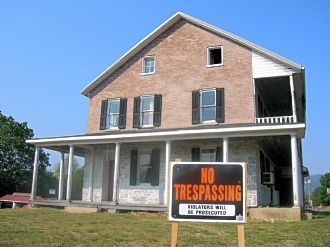
The Smith House is located next to the MMP&W Volunteer Fire Co. The board that oversees the fire company says it needs the land to expand its aging facilities. Len Barcousky/Post-Gazette
A Franklin County doctor has offered to relocate the historic Justice William Smith House in Mercersburg.
“I have a love of history,” Paul Orange said Monday.
He was reluctant to provide too many details of his proposal, but he said he was prepared to cover the costs of moving the two-story structure to a new location. Those expenses, including the cost of acquiring a suitable alternate property, could run as high as $100,000.
Dr. Orange has a family practice along Route 30 in Fayetteville, which is between Chambersburg and Gettysburg. He said he moved to the area in part because of its ties to important events during the Civil War. He is a graduate of Greensburg Central Catholic High School and St. Vincent College. After graduating from medical school at the American University of the Caribbean, he did his residency at Latrobe Hospital.
The Smith House is located next to the MMP&W Volunteer Fire Co. on Mercersburg’s Main Street. The board that oversees the fire company says it needs the land on which the house sits to expand its aging facilities, and it has sought bids for demolition of the building. Its initials stand for Mercersburg, Montgomery, Peters and Warren, which are the communities it serves.
The bids are to be opened Thursday, but the fire company has not said when it will award the contract.
Dr. Orange said he has submitted an offer to move the structure, which would save the fire company the expense of tearing it down.
His proposal has gained the support of a small citizens group, the Committee to Save the William Smith House, which has sought to head off any demolition plans.
“This is an amazing turn just when I thought we were dead in the water,” said Karen Ramsburg, who heads the Smith House committee. “I’m surprised and excited.”
One potential new home for the 18th-century building is the nearby site of a former gas station owned by the First National Bank of Mercersburg.
“The best-case scenario would be to keep the house in its current location,” Ms. Ramsburg said. “Moving it across the street would be the next best thing.”
In 1765, the Smith House was the meeting place for mainly Scotch-Irish settlers who organized themselves into a militia for defense against Indian raids.
Their efforts morphed into attacks on British supply trains and a siege of a nearby British military base called Fort Loudoun. Those early instances of armed resistance took place eight years before the Boston Tea Party and 10 years before the battles of Lexington and Concord.
“It could be said that people in this house provided the spark for the American Revolution,” Dr. Orange said.
Architectural details and property records indicate that the house was built between 1751 and 1759, which includes a portion of the French and Indian War. Porches and a second story were added during the 19th and 20th centuries.
The structure’s connection to the region’s early Scotch-Irish settlers has drawn the attention of an outdoor museum in Northern Ireland.
The Ulster American Folk Park has been working on plans to take apart the 18th-century “historic core” of the stone structure, ship it to Europe and reassemble it outside Belfast.
The folk park already has several other buildings from southwestern Pennsylvania with links to Scotch-Irish immigrants who settled here.
Members of the group seeking to save the house have said relocation to Northern Ireland was a better option than demolition, but they would prefer to have it remain in Franklin County.
Mercersburg is about 150 miles southeast of Pittsburgh.
-
South Side Real Estate Board Says Mission Accomplished
Monday, November 01, 2010By Diana Nelson Jones, Pittsburgh Post-Gazette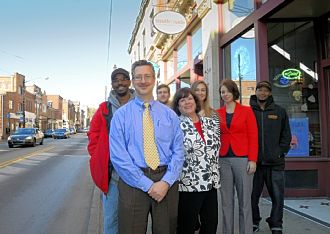
From left, Ron Goings, Rick Belloli, Aaron Sukenik, Judy Dyda, Rachael Glasder, Susie Puskar and DaVar Cutler of the South Side Local Development Co. -- Lake Fong/Post-Gazette
South Side Local Development Co., one of the most successful nonprofit real estate developers in Pittsburgh, will spend the next 18 months putting itself out of business.
The board decided to dissolve the little company whose 28-year tenure on the South Side has coincided with the neighborhood’s transformation in private property values, popularity and market economy.
A successor organization with a focus on public issues will be formed with community feedback to the South Side Planning Forum, the neighborhood’s umbrella for other groups, and the Pittsburgh Partnership for Neighborhood Development.
“This is an exciting transition, and I’m thinking of this as a huge success story,” said Ellen Kight, executive director of the Pittsburgh Partnership for Neighborhood Development. “They have really done what a (community development corporation) is supposed to do.”
Successful development corporations step in with public investment to help neighborhoods attract private investment. Some also have youth and job training programs, public safety committees and other outreach. The South Side nonprofit has largely focused on real estate and has built or renovated more than 100 homes in the past 20 years.
Private developers have added some 800.
“We’ve done our job,” said Tracy Myers, the company’s board president.
In 1982, when the company was founded, property values were two-thirds of the city’s median value, said executive director Rick Belloli. In 2008-09, those values were 170 percent of the city’s median. About 50 percent of the retail space along East Carson Street was vacant in 1982, and that rate is now at about 10 percent, he said.
Rob Stephany, executive director of the Urban Redevelopment Authority, said there is still work to be done by a high-capacity real estate nonprofit in the South Side’s adjacent neighborhoods.
“The target area is big, and the next step would be moving that [real estate] strength to the next frontier,” including Allentown and Arlington, he said.
“Clearly from a real estate value standpoint, the [development company] has been an invaluable piece of the puzzle,” he said. “The equity senior citizens have in their homes is growing, and that’s a proud moment. The fact that there are $400,000 sales in the South Side astounds me to this day.”
The remaining challenges largely have to do with the proliferation of bars, said Ms. Myers. “That’s a consequence of our success.”
The East Carson corridor’s accumulation of liquor licenses is considered to be at saturation by most stakeholders. Uncivil and drunken behavior on weekend nights has some homeowners at the breaking point. Resident Thomas Kolano said he is “very concerned a lot of people are actually talking about leaving the neighborhood.”
“If there isn’t a push-back from residents, this could become an undesirable place to live,” he said. “Sunday through Wednesday and some Thursdays it functions as a normal neighborhood — beautiful and vibrant. I love it. But Friday and Saturday are crazy. It’s like Jekyll and Hyde.”
The city has cracked down on parking violations in recent weeks, and Councilman Bruce Kraus has held several meetings to promote a management strategy for Carson businesses.
Mr. Stephany said a neighborhood improvement district “is an essential next step. The only way to correct some of the issues there is to have collaborative problem solving.”
A neighborhood improvement district is like a business improvement district, except it includes interests beyond those of businesses, such as parks. Participants pay a fee to have the interests of their stated district managed and maintained. The Pittsburgh Downtown Partnership is one example of a business improvement district.
A management strategy for East Carson businesses was recommended several years ago by consultants from the International Downtown Association. A committee of the South Side Planning Forum is gathering feedback to determine the range of focus of the successor organization.
The Pittsburgh Partnership for Neighborhood Development paid for an employee to go door-to-door to gather that feedback. The staff of the local development company will not be involved in the successor agency, although some of its board may be.
Ms. Myers said that while winding down, the agency “still has properties and buildings we want to make sure are well cared for. Some entity needs to keep an eye on these things, to protect all the progress we’ve made to improve the physical environment” and ensure that developers follow historic guidelines.
“Some things we do will have to be done by someone else or not get done,” she said. “The community has to set its priorities.”
-
Real Estate Workshop Celebrates City Living
Monday, November 01, 2010By Joe Smydo, Pittsburgh Post-GazetteUp hills, along tight curves and down into the river valleys, a bus full of local real-estate agents navigated Pittsburgh last week on a tour the Urban Redevelopment Authority put together to boost city home sales.
“I just got a whole different perspective,” said Mary Lynne Deets, education manager for the Realtors Association of Metropolitan Pittsburgh, who sold only about five homes in the city during a 30-year sales career.
That’s the kind of statistic the URA would like to change.
While open to all real estate professionals, the tour was designed to enlighten suburban agents unfamiliar with the city and all it has to offer. Officials hope their upbeat message will hit home, many times over.
“A lot of people want a walkable, pedestrian-friendly community to live in with a lot going on. That’s what urban living is all about,” said Kyra Straussman, URA real estate director.
Ms. Straussman said the URA ramped up home marketing efforts at Mayor Luke Ravenstahl’s direction about three years ago.
In May, the URA launched a Web site — Pittsburghcityliving.com — that pairs prospective home buyers with neighborhoods meeting their requirements. “It’s like Match.com for your neighborhood,” Ms. Straussman said.
The workshop for real estate agents, “City Living: A Focus on the Pittsburgh Client,” was another phase of the initiative. It was developed by Ms. Straussman; Josette Fitzgibbons, coordinator of the Mainstreets and Elm Street programs; and Megan Stearman, Mainstreets development specialist.
About 20 agents, most with little knowledge of the city, signed up. Under a special arrangement with the state Real Estate Commission, all received continuing education credits needed to maintain their licenses.
The agents saw new construction on the Central North Side, in Fineview and at Summerset at Frick Park. They heard about the house-by-house revival of Friendship, the development spurt in East Liberty and Lawrenceville’s recent emergence as a hot housing market.
They visited Riverview Park on the North Side, Pittsburgh Phillips K-5 on the South Side and Pittsburgh Brashear High School in Beechview. Sometimes, “neighborhood ambassadors” climbed aboard to talk about their communities and how civic groups augment the development work of city agencies.
“You know, we had rave reviews from the ‘students,’ ” Ms. Deets said, noting most continuing education workshops for real estate agents are classroom sessions on such issues as tax assessment and foreclosures.
Because the workshop was unusual, the Realtors Association had to persuade the Real Estate Commission to give the continuing education credits, Ms. Deets said. The participants did spend some time in a classroom, learning about tax abatement, other home buyer incentives and the Pittsburgh Public Schools.
To address concerns about the quality of city schools, the URA scheduled presentations about city magnet programs, the district’s academic improvement efforts and the Pittsburgh Promise college scholarship program. To counter other concerns about urban living, the URA arranged for the group to meet a man who’s raising two teenage girls on the South Side Flats and a single woman who lives in Allegheny West.
The URA plans to offer the workshop again in the spring. In the meantime, to track the success of last week’s program, the URA will send a thank-you gift to any participant who provides verification of a city home sale.
Ellen Connelly, a Howard Hanna agent who works mostly in the city, said the tour will make her job easier.
“I have an out-of-town client coming in. She’s looking at Sewickley. She’s looking at Fox Chapel. But she’s really focused on the city,” Ms. Connelly said.

